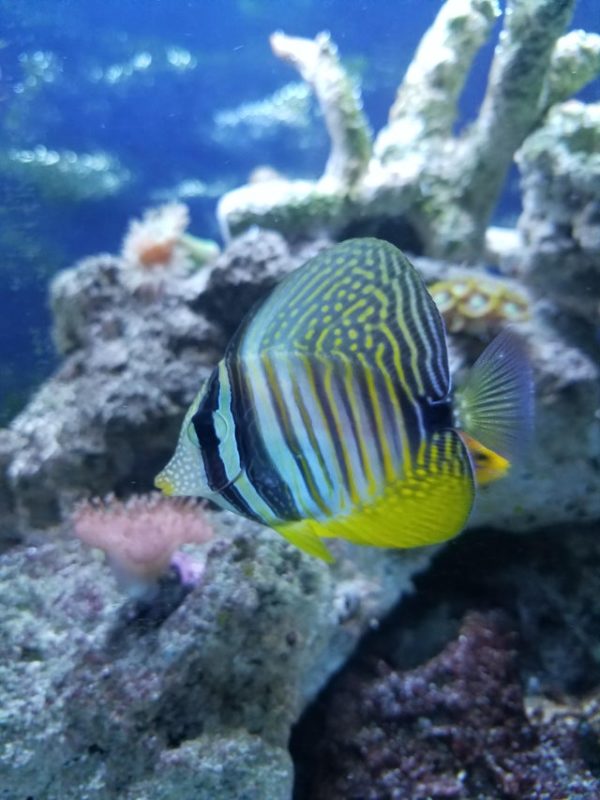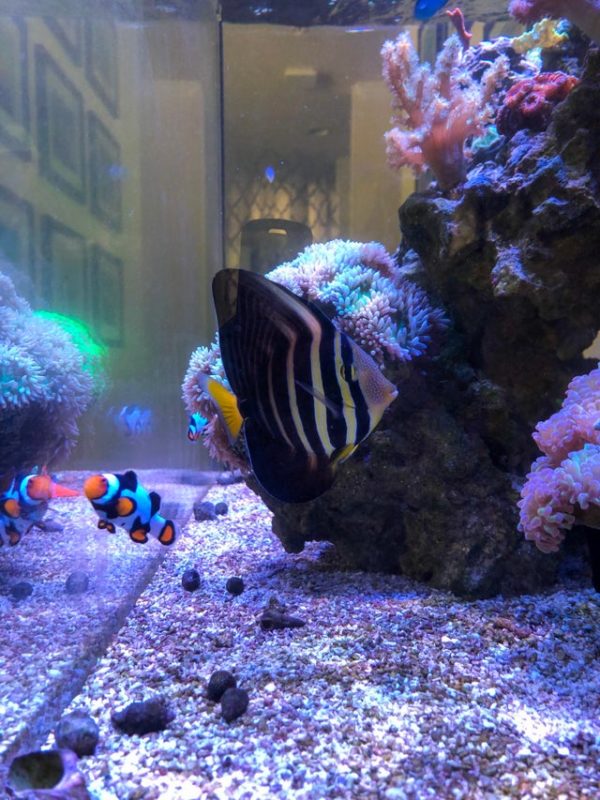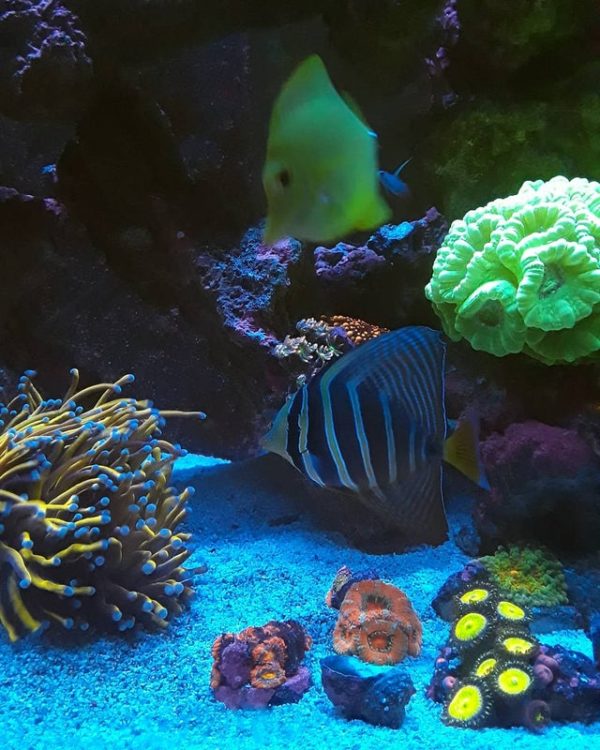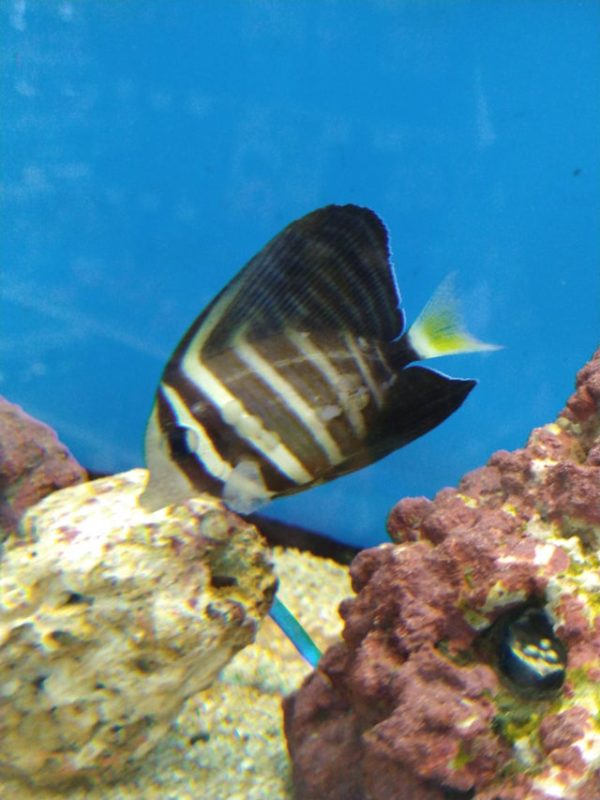You can pet various aquatic creatures in your home tank and enjoy the view. The fascinating creatures and their liveliness will never fail to fill your entire house with a rejuvenating vibe. Home aquatic tanks pose various benefits on your mental and children’s wellbeing.
Petting colorful aquatic animals have proven to calm children and help Alzheimer’s patients. But, those are just a few added benefits. Therefore, a home tank is a must-add feature to your living or office space regardless of your purpose.
Table of Contents
Sailfin Tang: A Brief Introduction
Sailfin tangs are tropical marine fish known for their tall, sail-like fins and vibrant colors. They are native to the reefs of the Indian and Pacific Oceans and are popular additions to saltwater aquariums. Sailfin tangs require a large tank with plenty of swimming space and a diet of marine algae and live rock.
Sailfin Tang Overview
Deciding and choosing the aquatic species for your aquarium tank can be daunting. It causes a dilemma among first-time aquarists or fish keepers. So, as a hobbyist who desires to have a wonderful addition to their home tank, you can try keeping the Sailfin Tang Fish.
Among its various attributes is the overwhelming beauty coupled with its peaceful nature. Unlike various other exotic and aggressive species, Sailfin Tang Fish can cohabit with other species without causing you any trouble. It quickly acclimatizes to most tank conditions and has straightforward needs, making it a good fish for beginner hobbyists.
| Information Chart | |
| Scientific Name: | Zebrasoma veliferum |
| Family: | Acanthuridae |
| Care Level: | Easy |
| Temperament: | Peaceful(aggressive with own kind) |
| Color: | Yellow, Purple, Striped |
| Lifespan: | 35-40 yrs |
| Size: | 7.9-15.7 inch |
| Diet: | Herbivore |
| Minimum Tank Size: | 70-180 gallons |
| Temperature: | 72 to 78˚F (22 to 26˚C) |
| Water Conditions: | Hardness: 440 ppm, pH 8.1-8.4 |
| Tank Mate Compatibility | Other Peaceful Similar Fish |
Sailfin Tang Appearance

The sailfin tang is disk-shaped, with a body similar to most surgeonfish.
The dorsal and anal fins are enormous and approximately the same size as the surgeonfish’s body. Whenever the fins of this fish extend, the total height and length become almost the same. Like other fish of the same family, the snout is extended.
The Sailfin tangs usually have fewer pharyngeal teeth than others of the same genus, Zebrasoma. However, the size of pharyngeal teeth is larger. They also have scalpels to fend off the enemies. Those are sharp structures appearing like spines, and we can find them on either side of the caudal peduncle. The primary purpose of the scalpels is to exert physical dominance on the attackers. Hence they serve as helpful defense structures. Since the Sailfin Tang is a peaceful creature, the scalpels are usually folded inside grooves and taken out only during danger.
Being a species in the Zebrasoma genus, the physical appearance of this fish is incomplete without mentioning the stripes.
The sailfin tang has small yet beautiful yellow and darker band stripes. These bands justify their position in the genus Zebrasoma as they resemble a zebra-like appearance.
The bands extend and eventually blend into the anal and dorsal fins. These dark bands have markings on them and some dots. The head of this fish is entirely white, and it has yellow spots with a darker band running to the eye. Behind the same eye, there is a very dark band too. All these bands have yellow lines and dots. On the caudal fin is a bright yellow color.
At the base of the tail are sharp scales raised when it senses danger. An approaching enemy can be stung using these scales. The juveniles look like adults, with the only difference being that the younger sailfin fish has a more pronounced color. An adult sailfin tang is approximately 40cm or 15.7 inches.
Types/Varieties Of Sailfin Tang
The Yellow Tang
Unlike the Pacific Sailfin Tang, the yellow tang fish lacks alternating stripes. Instead, it features a very bright yellow coloration throughout its entire body. This type of Sailfin fish is a common choice as an aquarium fish due to its attractive bright yellow color. It stands out from the rest of the population with its unique and beautiful color.
The Yellow Tang Fish is oval-shaped with long snouts. It has spiny dorsal and tail fins that can together go up to seven in number. Like other Sailfin types, the Yellow Tang fish also has scalpels. But here, you can find them on their tails. These scalpels are white and resemble sharp spines. They use scalpels as weapons while defending themselves against predators and use them for attacking, if necessary.
The Yellow Tang also possesses a unique color-changing ability multiple times a day. You can observe that it exhibits a color transition from bright yellow to grayish-yellow. We can see the bright yellow during daylight hours which shifts to grayish-yellow as the night falls. An appearance of white lateral stripes is also seen.
The Yellow Tang appears naturally in the Pacific. Therefore, you can find it commonly available from Hawaii to Japan. Additionally, you can also find it on the outer coasts of Florida in the Central Atlantic. They usually appear at depths ranging from 10 to 150 feet in outer reefs and lagoons.
The Yellow Tang mostly prefers to inhabit areas with dense corals. It helps them in hiding from predators. Usually, these fishes are found in singles but mostly in pairs. However, they also move in small groups. When they are young, the Yellow Tang prefer a solitary environment, and they have a secret behavior of hiding between the corals most of the time.
The Purple Tang
The Purple Tang is another gorgeous variety of Sailfin fish. They are among the most popular ones available for a saltwater aquarium for your home.
The Purple Tang differs from other varieties in having a more lateral length. It also has a round-shaped body instead of an oval shape, as in Yellow Tang. The circular impression is mainly due to the large dorsal and anal fins. The Purple Tang can grow up to 8-10 inches compared to the Yellow Tang, which can grow up to 7.9 inches.
As the name hints to us, the Purple Tang is a fish with its body covered in a hue of purple.
However, the shade can range from dark blue to purple. Additionally, there may be a varying darker shade in the middle portion. Their shape also resembles a disc, just like most Sailfin fishes. However, The Purple Tang has a peculiar feature of bright yellowtail.
Sometimes they may also appear with black spots or streaks. That usually appears somewhere on the face and the lighter portions of the body. You can also see that their glossy yellow tail fins also have yellow accents and their pectoral fins have lustrous tips. Historically, researchers believed they inhabited only the regions around the red sea. But, now we know that they can also be found in the western Indian Ocean, Gulf of Aden, the Persian Gulf, and the Arabian Sea.
Purple tangs typically inhabit coral reef ecosystems, commonly called reef fish. They eat filamentous algae in the reef as their primary food source. We can find them at depths that range from 2 to 20m.
Like the Yellow Tang Fish, the young prefer a solitary environment while the adults swim freely across shallow waters.
Lifespan Of A Sailfin Tang
The typical lifespan of a Sailfin Tang is 35-40years in captivity if adequately taken care of. Otherwise, they may not live more than 10-25 years. In some cases, depending on their variety, health, and captivity conditions, their life can end within 7-8 years.
Sailfin Tang Size
The typical Sailfin Tang grows up to 7.9 inches on the lower end and 15.7 inches for larger specimens. The males can grow up to 15.7 inches like in the Pacific Sailfin Tangs, whereas the females can cross around 12.5 inches.
Moreover, different varieties can have different size variations. For example, the yellow tang grows only 7.9 inches, whereas the purple tang can go up to 8-10 inches.
Natural Habitat And Origin
The sailfin fish is native to the Indian and Pacific Oceans. They majorly inhabit seaweed reefs and lagoons. These fishes are commonly available in Japan, Honolulu, Tuamotu, and Australia. The fish prefer to lead solitary lives hidden under corals or rocks during their juvenile stages. When they mature, we can spot them with partners. Some, however, stick to their solitary lifestyles. They can swim up to depths of 16-19 feet in the wild seas. They enjoy strong ocean currents and are often seen singly or in twos.
Sailfin Tang Care & Tank Set-Up
The sailfin tang enjoys wide swimming, which means they require plenty of water in its environment to be happy. The following tank conditions should suffice for it to be healthy:
Sailfin Fish Tank Size And Specifications

Optimum Tank Size For Sailfin Tang
The recommended tank size for Sailfin Tang is 70 to 180 gallons or more. Since these fishes are large and possess a decent life expectancy, they’ll require a large tank to be comfortable for a long time.
Tank Shape For Sailfin Tang
When a large tank with more than 100 gallons is needed, a cubical shape should best suit these Sailfin fishes. It will give them more length to roam freely and not cause any trouble.
Filter Type
Toxic wastes could accumulate in the tank if you do not remove and filter out the water from accumulating toxins. The best filters for a Sailfin tank would be Natural filters. The best way to filter their water is to keep them under the extremely glossy sunlight until all the areas are lit—following which the filter needs to be replaced.
Substrate
It is recommendable to choose a soft and smooth substrate. The Sailfin Tangs tend to swirl through the substrate, which can be harmful if the substrate is not soft.
How Many Sailfin Tangs In A 100-Gallon Tank
Though Sailfin Tangs are generally peaceful and do not trouble other kind-of species, they can get aggressive in a small tank. If the tank is in the 100 gallons range, only one should be kept per tank to give more space. However, if you want to keep a mated pair, the capacity of the tank should be more than 400 gallons.
Water Parameters For Sailfin Tang
The water parameters can play a significant role in determining the lifespan of your Tang fish. Therefore, you must duly adjust it.
Water Temperature
The ideal water temperature for Sailfin Tang is 72 to 78˚F (22 to 26˚C). These fishes are usually found in the pacific, requiring moderate temperatures to survive. So, to create an environment that resembles the temperate seas, you must set the temperature in the given range.
Water Flow Rate
Being broad swimmers, they require strong movement of water. The sailfin fish loves to feel rushing water ruffle its gills. Therefore, you must ensure an area of linear solid water flow for them to swim against the current.
For that, you can apply some water pressure on one side of the tank. So if there are other tank-mates, you should provide plenty of rocks as they love to enjoy lonely moments in hiding. The rocks can have enough crevices that they are likely to hide into.
pH Level
The perfect water pH level for Sailfin Tang is 8.1 to 8.4. It would be wise to be cautious about the pH level, as it decides whether the environment is habitable for the Sailfin. It is crucial to make its habitat accommodative.
Water Hardness
The hardness of your tank water should not be more than 440ppm. The water needs to have high amounts of dissolved oxygen for the Sailfin fish to survive. So, you should check the water hardness at least twice a week.
Sailfin Tang Tank Landscape
Setting up an ideal tank for your Sailfin Tang requires adding a few elements. Getting a massive tank of more than 100 gallons may not be sufficient. A large tank is essential to start with juveniles as they grow fast. But, adding rocks and corals is also necessary as it provides a sense of security.

Enough gravel is necessary, along with many nooks and crannies, to give them a safe and sound place to sleep.
Being a heavy algae feeder, a massive presence of algae is also necessary. Let us further look into what additional elements need to be introduced while setting up your tank.
Best Plants for Sailfin Tang Tanks
- Filamentous Algae
- Seagrass
- Small uproot plants
Worst Plants for Sailfin Tang Tanks
- Eichornia
- large plants
- poisonous plants
Decorations for Sailfin Tang Tanks
Corals and algae form the major component of their habitat. Hence, it would be best to keep corals glued down with a soft substrate. It is because their quick speeds may topple a coral or two. You should add plenty of algae and gravel to decorate the Sailfin tank.
Lighting for Sailfin Tang Tanks
This fish prospers under good amounts of light in the wild. You can provide good LED lighting with normal lighting conditions if certain places are dimly lit.
Feeding Sailfin Tang
They are primarily herbivores though they consume meaty foods too. In their natural habitat, they are known to feed green algae. To ensure their diet is similar to their wild, we recommend you the following meals:
Best Diet For Sailfin Tang
- Vegetables such as boiled or frozen lettuce, broccoli, spinach, or zucchini
- Provide an overgrowth of algae
- Frozen formulas of spirulina, mysid shrimp, and brine are other specialties
- Nori (a Japanese weed) and other kinds of seaweed mainly found in ocean basins
- Macro algae-like Chaetomorphia can be cultured in the tank to provide additional nutritional needs
Vitamins are another nutritional necessity. You should provide them with vitamins to fulfill their required nutritional needs. Remember, without vitamin c in its diet, chances of Lateral Line Erosion become high. It can be added to the water or soaked in dried pellets. Depending on its demands, you can feed the fish with these supplements at least three times a week or more.
How Often Should You Feed Sailfin Tang?
A Sailfin Tang should typically be fed a small amount of its meal 3 times a day. Instead of feeding them a large quantity daily, feeding smaller amounts in regular intervals will help these continuous grazers.
Sailfin Tang Behaviour And Temperament
They do not exhibit strange or unique behavior, making them an ideal tank addition. They have mild temperaments and can peacefully survive with plenty of other fish species. They, however, bully fish of their genus.
Most hobbyists report that when new tank mates are introduced into the aquarium, the old members chase them around, giving them little to no peace. To avoid this kind of scenario, simultaneously introduce many other preferred species into the tank.
When you introduce the same fish or other types of fishes into the sailfin’s aquarium, be mindful of changing the structure of the aquarium, as it is necessary. At least, this denies the sense of possessiveness.
Are Sailfin Tang Lone Or Societal In Nature?
When they are young, the Sailfin Tang prefers a solitary lifestyle. However, we can find them in groups or pairs when they mature.
Sailfin Tang Tank Mates
Ideal Sailfin Tang Tank Mates
- Chromis and Wrasses
- Cardinals
- Clownfish
- Large Angels
- Frogspawn Corals

Bad Tank Mates for Sailfin Tang
- Acanthurus
- Bristletooth tangs
Breeding Sailfin Tang
Male and female Sailfin Tangs have been known to spawn in groups. They may have multiple partners; however, they spawn only in pairs. We can see that they form large groups right before they spawn during breeding. That usually happens as the males start changing color.
The whole process coordinates with the lunar cycle in winter or early spring.
On the other hand, it can occur all year long in warmer waters. Once they have shot up to the surface, they release their very small gametes, less than 1 mm in size. They stay afloat with a single oil droplet. The hatching period is 24 hours after the poorly developed larvae are released. They undergo a further step-by-step process to take a recognizable form. Therefore, breeding Sailfin Tang under captivity can get complex with each step.
Sailfin Tang Breeding Level – Hard
Sailfin Tang Sexual Dimorphism
To distinguish between male and female Sailfin, we must look into its size. Distinguishing between males and females is often tricky in most fish species. However, in the Saiflin tang, males grow pretty larger than females making identification easy. Most successes with reproduction in this fish are reported in public aquariums. Some hobbyists have also reported they could breed them at home, though such cases are extremely few.
Sailfin Tang Common Diseases And Their Treatment
Saltwater Ich
Saltwater ich is a disease that can give your Sailfin Tang a hard time. It is caused by tiny parasites called Cryptocaryon. These parasites cause discomfort by embedding themselves in the fish’s skin and gills.
You can recognize the onset of this disease with the initial symptoms that include loss of appetite, rapid breathing, and scratching. However, it is a treatable disease.
You can use a copper-based aquatic medication to treat it.

Marine Velvet
Marine velvet is another most common disease experienced by fishes in a marine aquarium. It can occur in all the world’s oceans. The marine velvet is usually seen in wild and newly caught marine fish. So, if your Sailfin is newly caught, it is vulnerable to this disease. In saltwater fishes, it is caused by a parasitic skin flagellate, Oodinium ocellatum. Marine velvet is a contagious disease that can become fatal.
It mainly infects fish’s gills, but the parasite can also attach itself to the body. Subsequently, it can burrow deep into the skin’s subcutaneous layer. It becomes fatal when it interferes with the respiratory system.
Chemical treatments are available for this disease. You can use copper sulfate to tackle it. Generally, you can prevent it by maintaining the copper levels between 12-18 mg/L for 21 days.
Facts About Sailfin Tang
- The Sailfin Tang can feed on algae uncontrolled. That might eradicate it if the algae are not adequately stored.
- Some factors of bullying are peculiar to these fish. When you add a new fish, they tend to be anxious initially.
- Sailfins are generally mild-tempered and friendly with other fishes. However, we can often see them attacking their kind.
Distinguishing between the males and the females may get complicated in Sailfin Tangs as they have similar appearances, except in the sizes, wherein the males are larger than females.
Are Sailfin Tangs Right For You?
A Sailfin Tang can be an excellent option for everyone. It can be ideal for beginners and progressed saltwater fishkeepers alike. The diet of Sailfin does not require any fancy addition, and it can survive in most water conditions. Moreover, if you take care of it properly, it can have a considerable life span.
FAQs
Can You Keep Two Tangs Together?
Yes, you can, but you need to ensure that the tank’s capacity is more than 400 gallons.
Is Sailfin Tang Aggressive?
Usually, they have a peaceful behavior with most other fishes. However, they tend to attack their kind or lookalike.
Conclusion
Generally, keeping the sailfin tang is easy. It can handle various water conditions so long as consistency is maintained. It does well in a reef-only setting or where corals are available. It rarely interferes with the coral reefs.
The fish is disease resistant and can withstand lots of conditions in general. However, it is vulnerable to a few marine diseases. So if one notices there is some behavior change, seek treatment. Before doing so, ensure all the conditions are suitable. Check on the state of water, aeration, lighting, and pH. They have beautiful colors that you can maintain by proper feeding. If the color changes and becomes dull, check on its feeds and make changes if necessary.
They consistently need cleaning once in a while. Introducing the cleaner shrimp into the tank to do this is very important. The sailfin tang fish is a delight in a home aquarium. It is a worthy pet to keep.
